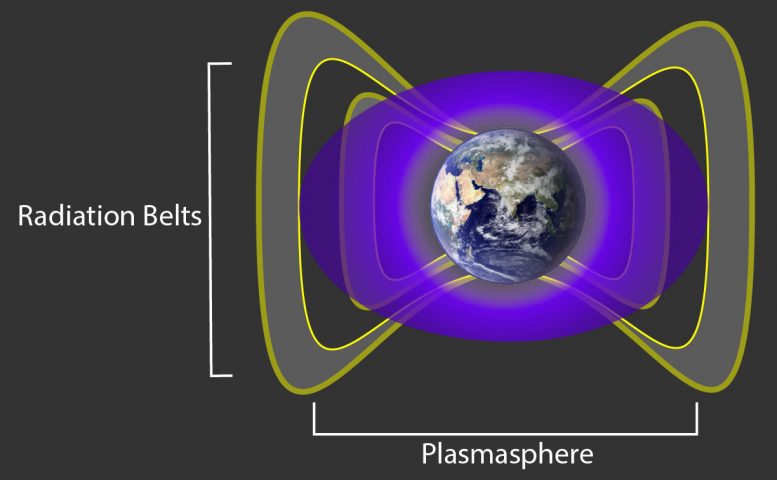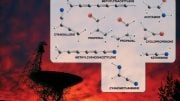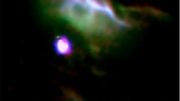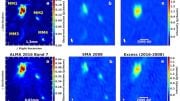Using NASA’s Van Allen Probes, new research reveals that the Van Allen radiation belts contain a nearly impenetrable barrier that prevents the fastest, most energetic electrons from reaching Earth.
This movie shows how particles move through Earth’s radiation belts, the large donuts around Earth. The sphere in the middle shows a cloud of colder material called the plasmasphere. New research shows that the plasmasphere helps keep fast electrons from the radiation belts away from Earth. Credit: NASA/Goddard/Scientific Visualization Studio
The Van Allen belts are a collection of charged particles, gathered in place by Earth’s magnetic field. They can wax and wane in response to incoming energy from the sun, sometimes swelling up enough to expose satellites in low-Earth orbit to damaging radiation. The discovery of the drain that acts as a barrier within the belts was made using NASA’s Van Allen Probes, launched in August 2012 to study the region. A paper on these results appeared in the November 27, 2014, issue of Nature magazine.
“This barrier for the ultra-fast electrons is a remarkable feature of the belts,” said Dan Baker, a space scientist at the University of Colorado in Boulder and first author of the paper. “We’re able to study it for the first time, because we never had such accurate measurements of these high-energy electrons before.”
Understanding what gives the radiation belts their shape and what can affect the way they swell or shrink helps scientists predict the onset of those changes. Such predictions can help scientists protect satellites in the area from the radiation.
The Van Allen belts were the first discovery of the space age, measured with the launch of a US satellite, Explorer 1, in 1958. In the decades since, scientists have learned that the size of the two belts can change – or merge, or even separate into three belts occasionally. But generally the inner belt stretches from 400 to 6,000 miles (640 to 9,700 kilometers) above Earth’s surface and the outer belt stretches from 8,400 to 36,000 miles (13,500 to 58,000 kilometers) above Earth’s surface.
A slot of fairly empty space typically separates the belts. But, what keeps them separate? Why is there a region in between the belts with no electrons?
Enter the newly discovered barrier. The Van Allen Probes data show that the inner edge of the outer belt is, in fact, highly pronounced. For the fastest, highest-energy electrons, this edge is a sharp boundary that, under normal circumstances, the electrons simply cannot penetrate.

A cloud of cold, charged gas around Earth, called the plasmasphere and seen here in purple, interacts with the particles in Earth’s radiation belts — shown in grey— to create an impenetrable barrier that blocks the fastest electrons from moving in closer to our planet. Credit: NASA/Goddard
“When you look at really energetic electrons, they can only come to within a certain distance from Earth,” said Shri Kanekal, the deputy mission scientist for the Van Allen Probes at NASA’s Goddard Space Flight Center in Greenbelt, Maryland and a co-author on the Nature paper. “This is completely new. We certainly didn’t expect that.”
The team looked at possible causes. They determined that human-generated transmissions were not the cause of the barrier. They also looked at physical causes. Could the very shape of the magnetic field surrounding Earth cause the boundary? Scientists studied but eliminated that possibility. What about the presence of other space particles? This appears to be a more likely cause.
The radiation belts are not the only particle structures surrounding Earth. A giant cloud of relatively cool, charged particles called the plasmasphere fills the outermost region of Earth’s atmosphere, beginning at about 600 miles up and extending partially into the outer Van Allen belt. The particles at the outer boundary of the plasmasphere cause particles in the outer radiation belt to scatter, removing them from the belt.
This scattering effect is fairly weak and might not be enough to keep the electrons at the boundary in place, except for a quirk of geometry: The radiation belt electrons move incredibly quickly, but not toward Earth. Instead, they move in giant loops around Earth. The Van Allen Probes data show that in the direction toward Earth, the most energetic electrons have very little motion at all – just a gentle, slow drift that occurs over the course of months. This is a movement so slow and weak that it can be rebuffed by the scattering caused by the plasmasphere.
This also helps explain why – under extreme conditions, when an especially strong solar wind or a giant solar eruption such as a coronal mass ejection sends clouds of material into near-Earth space – the electrons from the outer belt can be pushed into the usually-empty slot region between the belts.
“The scattering due to the plasmapause is strong enough to create a wall at the inner edge of the outer Van Allen Belt,” said Baker. “But a strong solar wind event causes the plasmasphere boundary to move inward.”
A massive inflow of matter from the sun can erode the outer plasmasphere, moving its boundaries inward and allowing electrons from the radiation belts the room to move further inward too.
Reference: “An impenetrable barrier to ultrarelativistic electrons in the Van Allen radiation belts” by D. N. Baker, A. N. Jaynes, V. C. Hoxie, R. M. Thorne, J. C. Foster, X. Li, J. F. Fennell, J. R. Wygant, S. G. Kanekal, P. J. Erickson, W. Kurth, W. Li, Q. Ma, Q. Schiller, L. Blum, D. M. Malaspina, A. Gerrard and L. J. Lanzerotti, 26 November 2014, Nature.
DOI: 10.1038/nature13956
The Johns Hopkins Applied Physics Laboratory in Laurel, Maryland, built and operates the Van Allen Probes for NASA’s Science Mission Directorate. The mission is the second in NASA’s Living With a Star program, managed by Goddard.









Uh…..how was it again we made it to the moon without being fried>?
Precisely. Amazing how the media never questions that sacred cow.
You exit through the areas that are weaker, simple as that.
With very good shielding and a limited exposure. If a large CME had occurred and they had flown through it, who knows what would have happened. Would the shielding on their ship have been suffient? I am not sure, but we might have ended up with fried astronauts. I’m glad nothing like that ever happened.
The astronauts were safe because they were enclosed in a metal spacecraft. Being a conductor, the metal allowed the electrons to arrange themselves on the sureface so that the electric field inside the craft was nullified. This is a direct consequence of the inverse square law of the electric force.
Perhaps you should contact NASA and inform them that you figured out how to get through the radiation belts, because they still haven’t figured it out..
Yes, they have figured out how to get through the van Allen belts. The people who say the NASA engineer slipped and revealed that “we still haven’t figured out” need a remedial grammar class.
They were in the Van Allen belt for too short a time to affect them.
If you wish to be fried you can always colonize Mars.
I’ve wondered about this for a while now.
But even with Starfish Prime, additional research into the Van Allen belts determined they weren’t a deal breaker for missions to the Moon. (By 1969, the high-energy electrons injected into the lower Van Allen belt by the Starfish Prime event had decayed to one-twelfth of its post-test peak intensity.) By February of 1964, NASA was confident that Apollo crews would be passing through the belts fast enough that the spacecraft’s skin and all the instrumentation lining the walls would be enough protection. It might seem foolhardy in hindsight for NASA to have accepted the risks of send astronauts through the Van Allen belts without extra protection, but it was a minor risk in the scheme of the mission.
We grew to be bigger than electrons and took some mylar shielding with us
Didn’t happen.
We have not been to the moon.
Uh…It’s called physics…Something you don’t understand based on your comment.
Well Brutus, our getting to the moon and back several times must prove that WE are not the fastest, high energy, relativistic ultra electrons that the Van Allen Belts repels. And as your 3rd grade teacher told you, read ALL your homework before asking Questions about it.
Impenetrable to electrons, not human spacecraft.
The length of time astronauts were exposed was not a lethal dose.
You would be fried if left there for years.
Idiots. Faking a lunar landing would be impossible due the the number of people required to keep the secret.
The Manhattan Project had over 125,000 people working in secret and it didn’t get out. So it can be done.
You realize you’re using a secret project we know about to say projects can be kept secret, right?
But it did get out. The soviets had spies.
Bet you believe in intelligent design too you moron.
Re Intelligent design: It’s easier to believe the Mona Lisa painting happened by an explosion in an art studio than believing the 40 components of a virus’ tail propulsion motor happened by chance.
Now remember! Such amazing feats such as this to protect us are all by chance…or so we’re told.
This is all something that Obama started when he was still a senator.
Quit acting like a moron!
Yes ,Isn’t it amazing how the so called geniuses are still not getting it that a bang just doesn’t put up all this protection and everything else that is in the world. I am amazed the ,,,,, no I am not going there. We know and if they do not want to hear it may be the best way to teach them is say BYBy we won’t see you again.
Nik,this is just more evidence that we are living in a vast computer simulation. God wouldn’t need to hide from us! But a couple programmers would! Just go online and search “Computer Universe Simulation,” and sees what comes up!
“the most energetic electrons have very little motion at all – just a gentle, slow drift that occurs over the course of months.”…eh?
I think by definition, the most energetic electrons will be moving incredibly fast. That’s sort of what “energetic” electrons means. Unless we are talking about excited electrons bound to nuclie, but we aren’t because this is plasma.
Sorry, I quit reading after the author demonstrated his lack of understanding.
Slowly, radially inward maybe? But those electrons are moving at relativistic speeds, guaranteed.
I hate to point this out but it’s been known almost since Van Allen charted these belts circa 1958. Each succeeding space exploration trip has shown that these belts contain protons as energetic as 100 MeV and that little to no electrons emitted from the Sun could penetrate that envelope.
The word ‘impenetrable’ does NOT apply to humans or our spacecraft… and frankly it is only applicable to certain charged particles with certain energies traveling at particular vectors.
But apparently, the term ‘impenetrable barrier’ was necessary to attract the attentions of even a tiny segment of our plebeian masses… to most people, ‘physics’ is merely a tabloid fascination, not anything to take seriously.
I think in the name of popularizing physics, the authors should have called the onion-like layers of the belts… ‘Phasors’, so that people would learn to fear them.
Plebeian masses? WTF?
The “barrier” is obviously the distances involved.
Wonder if the particles are negative the earths magnetic field cuasing them to be repelled, but at the same time gravity from the earch keeps them where they are. As these two forces fluctuate so does the thickness/distance of the particles from earch.
ANOTHER REASON WHY I DON’Y BUY THE MOON LANDING STORY!
And more reasons why some people believe the Earth is flat Marcial.
Thinking is hard and makes their head hurt
lol
Maybe it does not effect us as much as we think it does.. I don’t know if we knew of such things back in the day.. but that is most likely what is stopping us now a days is because we learned new things about how dangerous space can be and with all the space junk in our Orbit.. kinda makes things a little harder
It doesn’t stop gamma rays.
So how did the astronauts get through?
Wow! This is valuable information that can help prevent communication loss that may result in millions to billions of lost dollars and productivity. Another example of how well government works for the people.
This is precisely why the Russians abandoned their quest for the moon.
I thought K already established that in M.I.B.
Plebeian masses? WTF?
Yeah the moon landings were fake as are all the smart phones and other technologies we pretend to use. come on peeps
then, how’s that we have so many satellites flying out of the solar system, or near mars, mercury, even the sun, without getting fried by the radiation because they are far out the protection of the belt? always wandered that.
It’s wondered and because there all from the ground same with the moon…Why do you think we’ve only seen one side? We know it’s possible
And if you’ve heard of the space race in the cold war it makes sense why you would want to Photoshop for $9 billion a year that you are paying with your taxes…Everyone asks this question,until they do their research…😏
please someone help me did apollo 11 had a combustion engine?
It easier to fool people,than convince them they have been fooled. 30,000 to 1 were the odds of making it to the moon & back on first attempt.Fhey spent so much money they were forced to fake it,forcefly. That’s why Neil Armstrong never gave an interview…,,m
All the metals/Aluminium etc used to build the lunar modules melting points
Would mean the the module and everyone in it would of generated in the Thermosphere.